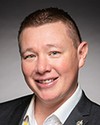Thank you.
Thank you and hello to Michael.
I work for the Indigenous Leadership Initiative and our goal is to grow guardians across the country. Our goal is to have the role of indigenous protected and conserved areas firmly embedded within the way governments across this country—and when I say “governments”, I include indigenous governments in that description—are taking care of land and taking care of waters.
What I was going to say earlier, and I think it fits well with this response, is that part of the solution is, yes, legislative avenues, but it's also resourcing in order for indigenous communities to be in an empowered position to work in partnership with other levels of government. When you empower our communities to work in partnership, it's a benefit not just to our communities, but actually to all Canadians. We can't do that unless we're properly resourced.
I've heard a lot of federal leaders talking about the importance of reconciliation and their respect for indigenous peoples and our nations, but for our nations, it's not an equal playing field. In my work experience, I've been working to grow these types of programming and this type of work within the north. It's enabled me to then step into these positions with the Indigenous Leadership Initiative, but I did it often with what felt like two hands tied behind my back.
We are not properly resourced to engage in this work. If we're going to address these issues and have our nations be in empowered positions, then we need investments. The federal government needs to play a very significant role in honouring investments into programs like indigenous guardians and into the exploration and establishment of indigenous protected and conserved areas.
From my perspective, it's not just about the legislative solutions. It's also about the investments that the federal government should be making and needs to be increasing into these types of programs.





